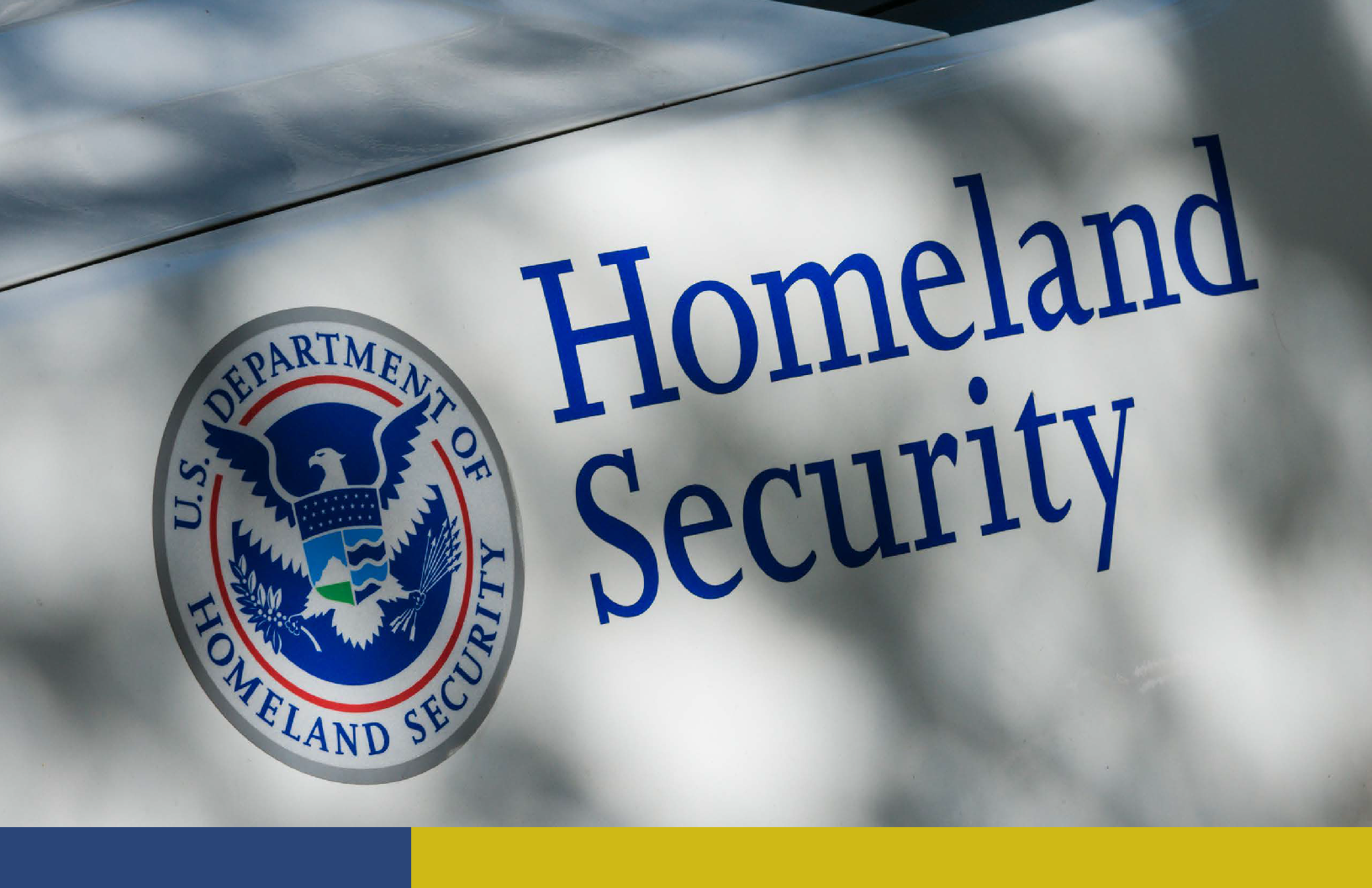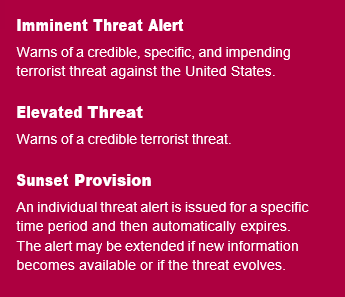
In 2011, the Department of Homeland Security (DHS) replaced the color-coded alerts of the Homeland Security Advisory System (HSAS) with the National Terrorism Advisory System (NTAS), designed to more effectively communicate information about terrorist threats by providing timely, detailed information to the American public.
It recognizes that Americans all share responsibility for the nation's security, and should always be aware of the heightened risk of terrorist attack in the United States and what they should do.
 NTAS Alerts
NTAS Alerts
When there is specific, credible information about a terrorist threat against the United States, DHS will share an NTAS Alert with the American public when circumstances warrant doing so. The Alert may include specific information, if available, about the nature of the threat, including the geographic region, mode of transportation, or critical infrastructure potentially affected by the threat, as well as steps that individuals and communities can take to protect themselves and help prevent, mitigate or respond to the threat. The Alert may take one of two forms: Elevated, if we have credible threat information, but only general informa- tion about timing and target such that it is reasonable to recommend implementation of protective measures to thwart or mitigate against an attack; or Imminent, if we believe the threat is credible, specific, and impending in the very near term.
NTAS Alerts contain a sunset provision that marks the expected expiration date of the Alert. Prior to this expiration date, if the threat information or conditions change, the Secretary of Homeland Security may announce an update to the advisory to amend, extend, or rescind it. All changes, including the announcement that cancels an NTAS advisory, will be distributed the same way as the original Alert or Bulletin.
If you see something, say something™ Report suspicious activity to local law enforcement or call 911.
Frequently Asked
Questions
In 2011, the Department of Homeland Security
(DHS) replaced the color-coded alerts
of the Homeland Security Advisory
System (HSAS) with the National Terrorism Advisory System (NTAS), designed to more effectively commu- nicate information about terrorist threats
by providing timely,
detailed information to the American
public.
NTAS will now consist of two types of advisories: Bulletins and Alerts. DHS has added Bulletins to the advisory system to be able to communicate current developments or general trends regarding threats of terrorism. NTAS Bulletins permit the Secretary to communicate critical terrorism information that, while not necessarily indicative of a specific threat against the United States, can reach homeland security partners or the public quickly, thereby allowing recipients to implement necessary protective measures. Because DHS may issue NTAS Bulletins in circumstances not warranting a more specific warning, NTAS Bulletins provide the Secretary with greater flexibility to provide timely information to stakeholders and members of the public.
As before, when there is specific, credible information about a terrorist threat against the United States, DHS will share an NTAS Alert with the American public when circumstances warrant doing so. The Alert may include specific information, if available, about the nature of the threat, including the geographic region, mode of transportation, or critical infrastructure potentially affected by the threat, as well as steps that individuals and communities can take
to protect themselves and help prevent, mitigate or respond to the threat. The Alert may take one of two forms: Elevated, if we have credible threat information, but only general information about timing and target such that it is reasonable to recommend implementation of protective measures to thwart or mitigate against an attack, or Imminent, if we believe the threat is credible, specific, and impending in the very near term.
DHS will announce the advisories publicly. All advisories will be simultaneously posted at DHS.gov, and released to the mainstream media for
distribution. DHS will also distribute advisories across its social media
channels, including Twitter and Facebook.
NTAS advisories — whether they be Alerts
or Bulletins — encourage individuals to follow the guidance provided by state and local officials and
to report suspicious activity. Where possible and applicable, NTAS advisories
will include steps that individuals and communities can take to protect themselves from the threat
as well as help detect or prevent an attack before it
happens. Individuals should review the information contained in the Alert or
Bulletin, and based upon the circumstances, take the recommended precautionary or preparedness measures for themselves
and their families.
NTAS Bulletins provide more general information about terrorism trends and potential threats in situations where
additional precautions may be warranted, but where circumstances do not indicate
a national threat
of sufficient credibility or specificity to issue an Alert. NTAS Bulletins summarize
the issue and why it’s important for public
awareness; outline U.S. Government counterterrorism efforts; and offer recommendations to the public on how it
can contribute to the overall counterterrorism effort.
Individuals should report suspicious activity to local law enforcement. Often, law enforcement and public safety officials are best positioned to provide specific details on what to look for and how to report suspicious activity. The “See Something, Say Something" campaign across the United States encourages the public and leaders of commu- nities to be vigilant for indicators of potential terrorist activity, and to follow the guidance provided by the advisory and/or state and local officials for information about threats in specific places.
Americans can go to DHS.gov/alerts to see the most recent advisories. Additionally, advisories will be sent out
widely through social and mainstream media.
NTAS Bulletins will establish mechanisms and set timelines to regularly re-evaluate the threat or risk identified in the Bulletin. Because it is based on more specific information, an NTAS Alert will include a “sunset provision" that marks the expected expiration date of the Alert. Prior to this expiration date, if the threat information or conditions change, the Secretary of Homeland Security may announce an update to the advisory to amend, extend, or rescind it. All changes, including the announcement that cancels an NTAS advisory, will be distributed the same way as the original Alert or Bulletin.
